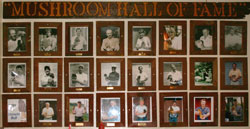mo·rel (mə-rěl')
n. Any of various edible mushrooms of the genus Morchella and related genera, characterized by a brownish spongelike cap.
While there are many species of edible wild mushrooms, morels are generally the most popular, especially here in the Midwest. Darrell Cox, a retired employee of the University of Illinois at Urbana-Champaign, has been hunting “the sponge on a stick” for more than 60 years. “I became especially enamored with morels,” he said, “because of their good taste, their mysterious appearance after rains each spring, and the notoriety of learning where they grew and how to find them when many others couldn’t.” Perhaps this love of mushrooms is what led to his Ph.D. in the field of botany.
John David Moore, an English professor at Eastern Illinois University, began his hunting career looking for chantrelles when he lived in the Pacific Northwest. His return to the Midwest prompted a switch to morels, as they “are the main reliable edible [mushroom] available in the spring.” He has been hunting since 1978 and has worked with Michael Kuo in the creation of the book 100 Edible Mushrooms.
Black and Yellow, True and False
All morels grow out of the ground; the part of the mushroom you see above ground is the “fruit.” They are distinguished by hollow, oval or cone-shaped caps with a ridged surface, and white, hollow stems that are either smooth or a bit wrinkled. According to Kuo’s book, there are two main types of morels—black and yellow. Black morels sprout first, and at maturity, their ridges turn black or dark brown, while the ridges of mature yellow morels are pale yellow or yellowish-brown.
Beware of false morels—they contain a poison called MMH (monmethylhydrazine), a toxic chemical commonly found in rocket fuel! A false morel has a wrinkled cap and a skirt hanging down around the stem, which is fleshy and full, rather than hollow. Do your research, and when in doubt, consult an expert—do not eat a mushroom if you are unsure of its type.
When and Where to Find Them
“Morels occur in the central states for a three or four week period in any one area,” Cox said. He starts his hunt in southern Illinois, Kentucky and Tennessee in late March and early April and follows the mushrooms as they move north with the weather. Cox doesn’t stop at Illinois, however; like Moore, he hunts well into Michigan and Wisconsin until the hunting season comes to a close.
Moore said morels grow just about anywhere—from beach sand and gravel driveways to tilled gardens and wild forests. Cox said he does most of his hunting in forested areas on hillsides and ravines in areas where he has found them to be abundant in previous years. Experience, he noted, is the best guide to finding morel mushrooms.
What to Look For
There do seem to be dead giveaways when it comes to locating morels. “The most reliable key for spotting them,” according to Moore, “is to understand their symbiotic relation with certain trees.” Morels are most commonly found under dead elm and living ash trees. Cox also noted that he looks for sycamores, cottonwoods, silver maples, old apple orchards, and sometimes even white and red pine trees. “Morels appear first where soil warms first—search south-facing slopes early, then east- and west-facing slopes, and lastly, north-facing hills. The soil warms earliest where leaf cover is sparse and later where it’s covered by a thick layer of leaf mulch.”
Hunting Supplies
- PAPER BAGS—never plastic. Plastic bags hold the moisture in and can turn your mushroom treasures to plain mush by the time you get home.
- POCKET KNIFE to cut the mushrooms off at the stem base so as not to disturb the actual plant, which runs under the ground.
- CAMERA.
- BINOCULARS.
- NOTEBOOK and PEN to make notes about where you find morels.
- WALKING STICKS to sort through leaves and brush.
- GPS SYSTEM or COMPASS so when you get caught up looking at the forest floor you can still find your way back to the car!
- CELL PHONE.
- INSECT/TICK REPELLENT.
Advice for Beginners
Cox advises beginners to go hunting with an experienced mushroom collector. This, he says, “can speed your learning to identify more and more mushrooms with confidence.” He also recommends joining a mushroom club, which also quickly increases your knowledge and confidence when it comes to morels. In addition, getting a hold of one or two good mushroom guides will be very helpful in learning to correctly identify wild mushrooms.
It’s also a good idea to keep a diary for each morel season, Cox says, “recording things that may be useful next year: temperatures, rainfall, where you go on each outing, the kinds of mushrooms you see and where, kinds of trees nearby, how many you find and where.” All of these things, he says, will help you become a more experienced, confident, observant and successful morel hunter.
Savory Concoctions
The classic method of preparing morels—dipping them in egg wash, rolling them in cracker- or breadcrumbs and frying in a skillet with butter—is just one way to do it. You might wow family or friends at your next gathering with one of the recipes in the sidebar to the right.

Cooking Wild Mushrooms
When eating wild mushrooms for the first time, it is a good idea to eat just one or two and leave others that came from the same place in the fridge in case you have a reaction and doctors need to identify exactly what made you sick. Cox notes that some people are allergic to morels, just like some are allergic to strawberries or peanuts. “You may also become ill from eating an edible mushroom which has been spoiled by something like contaminating bacteria and old age,” so be sure the morels you eat are fresh and properly cleaned.
Illinois State Morel Mushroom Championship
The 2008 Illinois State Morel Mushroom Championship will take place at the Marshall-Putnam Fairgrounds in Henry, Illinois, from May 2nd to May 4th. Buses depart for the two-hour hunt at 9:15am. For more information and a weekend schedule of events, visit www.ilmorelhunt.org.
 A Wall of Morels
A Wall of Morels
In 1982, Greg and Gene Gebhards’ love for hunting mushrooms prompted them to start the annual Schooner’s morel hunting contest. People begin bringing in morels during the third or fourth week in April, and judging takes place in May. Aside from being commemorated on the establishment’s wall, the first-place winner also receives $100. Check out their wall of fame at 730 E. War Memorial Drive. A&S


